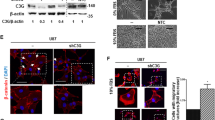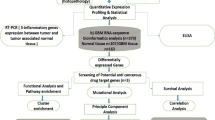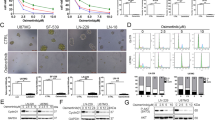Abstract
Primary glioblastomas (GBMs) commonly overexpress the oncogene epidermal growth factor receptor (EGFR), which leads to increased Ras activity. FTA, a novel Ras inhibitor, produced both time- and dose-dependent caspase-mediated apoptosis in GBM cell lines. EGFR-mediated increase in 3H-thymidine uptake was inhibited by FTA. FACS analysis was performed to determine the percent of apoptotic cells. The sub-Go population of GBM cells was increased from 4.5 to 13.8% (control) to over 45–53.6% in FTA-treated cells within 24 h. Furthermore, FTA also increased the activities of both caspase-3 and -9, and PARP cleavage. Treatment of GBMs with FTA before or after EGF addition to the cultures blocked phosphorylation of Akt and mitogen-activated protein kinases (MAPK). FTA also significantly reduced the amount of EGF-induced Ras-GTP as reflected by a decrease in the level of Ras bound to Raf-RBD-GST. This study demonstrates that inhibition of Ras methylation may provide a therapeutic target for the treatment of GBMs overexpressing EGFR.
Similar content being viewed by others
Log in or create a free account to read this content
Gain free access to this article, as well as selected content from this journal and more on nature.com
or
Abbreviations
- GBM:
-
Glioblastoma
- FTA:
-
Farnesylthiosalicylic acid
- EGFR:
-
Epidermal Growth Factor Receptor
- MAPK:
-
Mitogen-activated protein kinase
References
Kleiheus P and Caveness WK (2000) Tumours of the Nervous System: Pathology and Genetics Lyon: International Agency for Research on Cancer
Cairncross JG, Ueki K, Zlatescu MC, Lisle DK, Finkelstein DM, Hammond RR, Silver JS, Stark PC, Macdonald DR, Ino Y, Ramsay DA and Louis DN (1998) Specific genetic predictors of chemotherapeutic response and survival in patients with anaplastic oligodendrogliomas. J. Natl. Cancer Inst. 90: 1473–1479
Smith JS, Perry A, Borell TJ, Lee HK, O'Fallon J, Hosek SM, Kimmel D, Yates A, Burger PC, Scheithauer BW and Jenkins RB (2000) Alteration of 1p and 19q as predictors of survival in oligodendrogliomas. J. Clin. Oncol. 18: 636–645
Chakravarti A, Delaney MA, Noll E, Black PM, Loeffler JS, Muzikansky A and Dyson NJ (2001) Prognostic and pathologic significance of quantitative protein expression profiling in human gliomas. Clin. Cancer Res. 7: 2387–2395
Maher EA, Furnari FB, Bachoo RM, Rowitch DH, Louis DN, Cavenee WK and DePinho RA (2001) Malignant glioma: genetics and biology of a grave matter. Genes Dev. 15: 1311–1333
Krishnan S, Rao RD, James CD and Sarkaria JN (2003) Combination of epidermal growth factor receptor targeted therapy with radiation therapy for malignant gliomas. Front Biosci. 8: 1–13
Mayo LD, Dixon JE, Durden DL, Tonks NK and Donner DB (2002) PTEN protects p53 from Mdm2 and sensitizes cancer cells to chemotherapy. J. Biol. Chem. 277: 5484–5489
Broaddus WC, Liu Y, Steele LL, Gillies GT, Lin PS, Loudon WG, Valerie K, Schmidt-Ullrich RK and Fillmore HL. (1999) Enhanced radiosensitivity of malignant glioma cells after adenoviral p53 transduction. J. Neurosurg. 91: 997–1004
Hussaini IM, Sando JJ, Carpenter JE, Redpath GT, Shaffrey ME and VandenBerg SR (2002) Protein kinase C-η regulates resistance to UV- and γ-irradiation-induced apoptosis by preventing caspase-9 cleavage in astrocytomas. Neuro-Oncology 4: 9–13
Mischel PS and Cloughesy TF (2003) Targeted molecular therapy of GBM. Brain Pathol. 13: 52–61
Chakravarti A, Chakladar A, Delaney MA, Latham DE and Loeffler JS (2002) The epidermal growth factor receptor pathway mediates resistance to sequential administration of radiation and chemotherapy in primary human glioblastoma cells in a RAS-dependent manner. Cancer Res. 62: 4307–4315
Mercer JA (2000) Intercellular junctions: downstream and upstream of Ras? Semin. Cell Dev. Biol. 11: 309–314
Pells S, Divjak M, Romanowski P, Impey H, Hawkins NJ, Clarke AR, Hooper ML and Williamson DJ (1997) Developmentally-regulated expression of murine K-ras isoforms. Oncogene. 15: 1781–1786
Porfiri E and McCormick F (1996) Regulation of epidermal growth factor receptor signaling by phosphorylation of the ras exchange factor hSOS1. J. Biol. Chem. 271: 5871–5877
Maity A, Pore N, Lee J, Solomon D and O'Rourke DM (2000) Epidermal growth factor receptor transcriptionally up-regulates vascular endothelial growth factor expression in human glioblastoma cells via a pathway involving phosphatidylinositol 3′-kinase and distinct from that induced by hypoxia. Cancer Res. 60: 5879–5886
Omer CA and Kohl NE (1997) CA1A2X-competitive inhibitors of farnesyltransferase as anti-cancer agents. Trends Pharmacol. Sci. 11: 437–444
Gelb MH (1997) Protein prenylation, et cetera: signal transduction in two dimensions. Science. 275: 1750–1751
Gribbs JB (1993) Lipid modification of proteins in the Ras superfamily In: GTPases in Biology Birnbaumer L, Dickey B (eds). New York NY: springer-Verlag, pp 335–344
Zhang FL, Kirschmeier P, Carr D, James L, Bond RW, Wang L, Patton R, Windsor WT, Syto R, Zhang R and Bishop WR (1997) Characterization of Ha-ras, N-ras, Ki-Ras4A, and Ki-Ras4B as in vitro substrates for farnesyl protein transferase and geranylgeranyl protein transferase type I. J. Biol. Chem. 272: 10232–13239
Whyte DB, Kirschmeier P, Hockenberry TN, Nunez-Oliva I, James L, Catino JJ, Bishop WR and Pai JK (1997) K- and N-Ras are geranylgeranylated in cells treated with farnesyl protein transferase inhibitors. J. Biol. Chem. 272: 14459–14464
Sun J, Qian Y, Hamilton AD and Sebti SM (1998) Both farnesyltransferase and geranylgeranyltransferase I inhibitors are required for inhibition of oncogenic K-ras prenylation but each alone is sufficient to suppress human tumor growth in nude mouse xenografts. Oncogene 16: 1467–1473
Paz A, Haklai R, Elad-Sfadia G, Ballan E and Kloog Y (2001) Galectin-1 binds oncogenic H-Ras to mediate Ras membrane anchorage and cell transformation. Oncogene 20: 7486–7493
Brunner TB, Hahn SM, Gupta AK, Muschel RJ, McKenna WG and Bernhard EJ (2003) Farnesyltransferase inhibitors: an overview of the results of preclinical and clinical investigations. Cancer Res 63: 5656–5668
Marom M, Haklai R, Ben-Baruch G, Marciano D, Egozi Y and Kloog Y. (1995) Selective inhibition of Ras-dependent cell growth by farnesylthiosalisylic acid. J. Biol. Chem. 270: 22263–22270
Nozaki M, Tada M, Kobayashi H, Zhang CL, Sawamura Y, Abe H, Ishii N and Van Meir EG (1999) Roles of the functional loss of p53 and other genes in astrocytoma tumorigenesis and progression. Neuro-oncology 1: 124–137
Herrmann C, Horn G, Spaargaren M and Wittinghofer A (1996) Differential interaction of the ras family GTP-binding proteins H-Ras, Rap1A, and R-Ras with the putative effector molecules Raf kinase and Ral-guanine nucleotide exchange factor. J. Biol. Chem. 271 (12): 6794–6800
Datta SR, Brunet A and Greenberg ME (1999) Cellular survival: a play in three Akts. Genes Dev. 13: 2905–2927
Xia Z, Dickens M, Raingeaud J, Davis RJ and Greenberg ME (1995) Opposing effects of ERK and JNK-p38 MAP kinases on apoptosis. Science 270: 1326–1331
Erhardt P, Schremser EJ and Cooper GM (1999) B-Raf inhibits programmed cell death downstream of cytochrome c release from mitochondria by activating the MEK/Erk pathway. Mol. Cell. Biol. 19: 5308–5315
Le Gall M, Chambard JC, Breittmayer JP, Grall D, Pouyssegur J and Van Obberghen-Schilling E (2000) The p42/p44 MAP kinase pathway prevents apoptosis induced by anchorage and serum removal. Mol. Biol. Cell 11: 1103–1112
von Gise A, Lorenz P, Wellbrock C, Hemmings B, Berberich-Siebelt F, Rapp UR and Troppmair J (2001) Apoptosis suppression by Raf-1 and MEK1 requires MEK- and phosphatidylinositol 3-kinase-dependent signals. Mol. Cell. Biol. 21: 2324–2336
Allan LA, Morrice N, Brady S Magee G, Pathak S and Clarke PR (2003) Inhibition of caspase-9 through phosphorylation at thr125 by ERK MAPK. Nature Cell Biol. 5: 647–654
Haklai R, Weisz MG, Elad G, Paz A, Marciano D, Egozi Y, Ben-Baruch G and Kloog Y (1998) Dislodgment and accelerated degradation of Ras. Biochemistry 37: 1306–1314
Weisz B, Giehl K, Gana-Weisz M, Egozi Y, Ben-Baruch G, Marciano D and Gierschik P and Kloog Y (1999) A new functional Ras antagonist inhibits human pancreatic tumor growth in nude mice. Oncogene 18 (16): 2579–2588
Jansen B, Schlagbauer-Wadl H, Kahr H, Heere-Ress E, Mayer BX, Eichler H, Pehamberger H, Gana-Weisz M, Ben-David E, Kloog Y and Wolff K (1999) Novel Ras antagonist blocks human melanoma growth. Proc. Natl. Acad. Sci. USA 96: 14019–14024
Clarke S (1992) Protein Isoprenylation and methylation at carboxy-terminal cystein residues. Annu. Rev. Biochem. 61: 355–386
Smalley KSM and Eisen TG (2002) Farnesyl thiosalicylic acid inhibits the growth of melanoma cells through a combination of cytostatic and pro-apoptotic effects. Int. J. Cancer 98: 514–522
McPherson RA, Conaway MC, Gregory CW, Yue W and Santen RJ (2004) The novel Ras antagonist, farnesylthiosalicylate, suppresses growth of prostate cancer in vitro. Prostate 58: 325–334
Rowinsky EK, Windle JJ and Von Hoff DD (1999) Ras protein farnesyltransferase: A strategic target for anticancer therapeutic development. J. Clin. Oncol. 17: 3631–3652
Blum R, Jacob-Hirsch J, Amariglio N, Rechavi G and Kloog Y (2005) Ras inhibition in glioblastoma down-regulates hypoxia-inducible factor-1α, causing glycolysis shutdown and cell death. Cancer. Res. 65: 999–1006
Shohami E, Yatsiv I, Alexandrovich A, Haklai R, Elad-Sfadia G, Grossman R, Biegon A and Kloog Y (2003) The Ras inhibitor S-trans, trans-farnesylthiosalicylic acid exerts long-lasting neuroprotection in a mouse closed head injury model. J. Cereb. Blood Flow Metab. 23: 728–738
Hussaini IM, Karns LR, Griffith V, Carpenter JE, Redpath GT, Sando JJ and VandenBerg SR (2000) Phorbol 12-myristate-13-acetate induces protein kinase C-η-specific proliferative response in astrocytic tumor cells. J. Biol. Chem. 275: 22348–22354
Amos S, Martin PM, Polar GA, Parsons SJ and Hussaini IM (2005) Phorbol 12-myristate 13-acetate induces epidermal growth factor receptor transactivation via protein kinase Cδ/c-Src pathways in glioblastoma cells. J. Biol. Chem. 280: 7729–7738
Acknowledgements
This work was supported by grants from the National institute of Health, CA 98508 and NS35122 (IMH).
Author information
Authors and Affiliations
Corresponding author
Additional information
Edited by CJ Thiele
Rights and permissions
About this article
Cite this article
Amos, S., Redpath, G., Polar, G. et al. Farnesylthiosalicylic acid induces caspase activation and apoptosis in glioblastoma cells. Cell Death Differ 13, 642–651 (2006). https://doi.org/10.1038/sj.cdd.4401783
Received:
Revised:
Accepted:
Published:
Issue date:
DOI: https://doi.org/10.1038/sj.cdd.4401783
Keywords
This article is cited by
-
Perillyl alcohol, a pleiotropic natural compound suitable for brain tumor therapy, targets free radicals
Archivum Immunologiae et Therapiae Experimentalis (2017)



